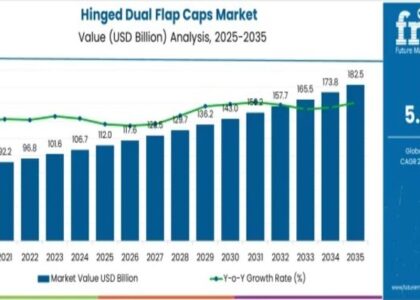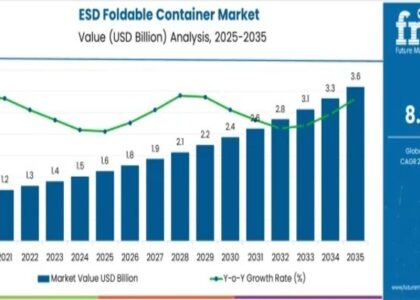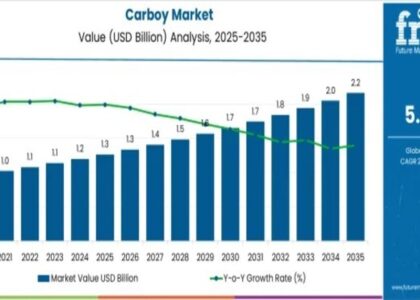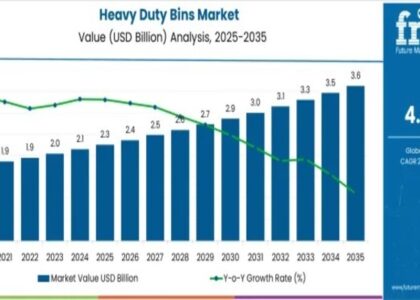 Anticipated to hit US$ 11.6 billion by 2023, the global disposable cups market is poised for substantial growth, with a projected Compound Annual Growth Rate (CAGR) of 6.2% between 2023 and 2033. By 2033, this market is expected to soar to US$ 21.1 billion. Notably, the top three countries are forecasted to collectively capture approximately 40% to 45% of the market share by 2023. This growth trajectory underscores the enduring demand for disposable cups, driven by various factors such as convenience, lifestyle changes, and evolving consumer preferences, paving the way for a lucrative market landscape in the coming years.
Anticipated to hit US$ 11.6 billion by 2023, the global disposable cups market is poised for substantial growth, with a projected Compound Annual Growth Rate (CAGR) of 6.2% between 2023 and 2033. By 2033, this market is expected to soar to US$ 21.1 billion. Notably, the top three countries are forecasted to collectively capture approximately 40% to 45% of the market share by 2023. This growth trajectory underscores the enduring demand for disposable cups, driven by various factors such as convenience, lifestyle changes, and evolving consumer preferences, paving the way for a lucrative market landscape in the coming years.
Various environmentally conscious alternatives for disposable plastic cups, including polylactic acid, plant starch, and maize starch, have emerged, promoting eco-friendly choices. The production of 100% compostable, sustainable, and disposable cups requires significantly less energy, further emphasizing the ecological benefits of these options. The escalating consumer preference for compostable and recyclable cups, suitable for both hot and cold beverages, is expected to drive an upsurge in disposable cup sales. This growing inclination towards sustainable solutions reflects a broader shift towards environmentally responsible practices in response to increasing environmental concerns and a desire for greener alternatives.
Experiencing a Compound Annual Growth Rate (CAGR) of 3.1% in the past, the global disposable cups market displayed steady progress. Beginning at a worth of US$ 8.6 billion in 2014, it climbed to US$ 11.0 billion by 2022. Recognized for their cost-effectiveness and environmentally sustainable attributes, disposable cups serve as economical and eco-friendly packaging alternatives.
Request Sample Report: https://www.futuremarketinsights.com/reports/sample/rep-gb-2639
As they are unbreakable, time-saving, and easy to clean, paper or disposable plastic cups are preferred by food service operators over glass ones. Numerous fast food restaurants, cafeterias, and food malls use disposable cups as a dependable, safe, and simple packaging solution. These can be delivered to clients quickly, which would expand the disposable cups market.
Business Growth Drivers:
- Convenience and On-the-Go Lifestyle: Disposable cups cater to the fast-paced lifestyle of modern consumers who seek convenience. They are preferred for quick service at cafes, restaurants, and events.
- Hygiene Concerns: Especially in the wake of health crises like COVID-19, there’s an increased emphasis on hygiene and sanitation. Disposable cups are perceived as more hygienic than reusable cups, driving their demand.
- Eco-Friendly Alternatives: Rising awareness about environmental issues and the harmful effects of plastic pollution have led to a shift towards eco-friendly disposable cups made from materials like paper, PLA (polylactic acid), or bagasse (sugarcane fiber).
- Customization and Branding Opportunities: Disposable cups offer businesses a platform for branding and customization, providing an opportunity for companies to promote their brand through innovative designs and printing techniques.
- Growing Foodservice Industry: The expansion of the foodservice industry, including cafes, fast-food chains, and food delivery services, has fueled the demand for disposable cups as they are an essential part of serving beverages.
- Regulatory Support: Government regulations and bans on single-use plastics in various regions have accelerated the adoption of alternative materials for disposable cups, boosting the market growth for eco-friendly options.
- Technological Advancements: Innovations in cup design and manufacturing processes, such as improved insulation, leak-proofing, and compatibility with hot and cold beverages, enhance the appeal and functionality of disposable cups.
Industry Restraints:
- Environmental Concerns: Despite the shift towards eco-friendly options, disposable cups still contribute to environmental pollution, especially if not disposed of properly. This has led to increasing scrutiny and calls for further reduction or alternative solutions.
- Cost Considerations: Eco-friendly disposable cups made from alternative materials are often more expensive to produce compared to traditional plastic cups. This cost differential can be a barrier for some businesses, especially smaller ones.
- Limited Recycling Infrastructure: While some disposable cup materials are technically recyclable, the lack of proper recycling infrastructure and consumer awareness often leads to low recycling rates, exacerbating environmental issues.
- Consumer Behavior: Despite growing awareness, consumer habits and preferences, including the convenience of single-use items and resistance to change, can slow down the adoption of more sustainable alternatives.
- Supply Chain Challenges: Fluctuations in raw material prices, supply chain disruptions, and logistical issues can impact the production and distribution of disposable cups, affecting market stability and growth.
- Competitive Pressure: The disposable cups market is highly competitive, with numerous players offering similar products. Intense competition can lead to pricing pressures and reduced profit margins for manufacturers and suppliers.
- Regulatory Uncertainty: Shifting regulatory landscapes, including evolving bans and regulations on single-use plastics, can create uncertainty for businesses in terms of compliance and future market conditions.
Key Takeaways from Disposable Cups Market
- Less than 250 ml disposable cups by capacity is projected to hold a substantial disposable cups market share of 52% by 2033.
- By material, the paper disposable cups segment is anticipated to accelerate by 1.8 times its present market value.
- The beverages segment by application is expected to create an absolute dollar opportunity of US$ 7.0 million during the forecast period.
- Europe followed by South Asia is estimated to generate high demand for disposable cups, accounting for around 44% of share by 2033.
- Australia disposable cups market is projected to exhibit a CAGR of 3.0% from 2023 to 2033.
Request Customization: https://www.futuremarketinsights.com/customization-available/rep-gb-2639
Competition Landscape:
Key players operating in the global disposable cups market are
- Pactiv LLC
- Berry Global Group, Inc.
- Dart Container Corporation
- Huhtamaki Oyj
- Detpak (Detmold Group)
- Georgia-Pacific LLC
- Greiner Packaging International GmbH
- Genpak, LLC.
Also, few of the other noticeable players in the market are Fuling Plastic USA, Inc., Churchill Container, ConverPack Inc., FrugalPac Limited, Go-Pak Group, Grupo Phoenix Capital Limited, CEE Schisler Packaging Solutions, F Bender Limited, SEDA International Packaging Group S.p.A., Duni Group Global, and Stanpac Inc. and others. Tier 1 players in the market hold 15 to 20% in the global disposable cups market.
“Increasing demand for on-the-go snacking is projected to propel sales of tea, coffee, lemonade, and soft drinks worldwide. It is projected to drive disposable cups sales in the next ten years. Key companies are likely to develop new cups with innovative materials to attract a large consumer base,” says a lead Future Market Insights analyst.
For instance,
- In July 2021, following single-use plastic ban in the European Union, Vegware updated their disposable cups’ design to comply with the single-use plastics directive.
- In June 2021, Novolex launched a new manufacturing line to produce compostable cups from plant-based plastic (polylactic acid) which appears, behaves, and performs just like a traditional plastic cup.
Plastic Ban in Significant Regions is Expected to Deter Disposable Cup Sales
Single-use plastic damages wildlife, flora, and fauna. It also pollutes the environment and uses up vital natural resources in its production. Due to the massive amount of plastic waste in landfills and the ocean, several nations have outlawed single-use plastics.
Around 15 million metric tonnes of plastic debris are dumped into the ocean annually, according to Oceana Inc. Every minute, around two trucks worth of plastic trash are produced and dumped into the ocean. More than any other nation, the USA produces a substantial amount of plastic waste. Devastating effects may result from the rapid increase in terms of plastic manufacturing.
Expanded polystyrene products are no longer available and are even prohibited in Europe. Purpose of this new rule named Single-Use-Plastics (SUP), is to lessen negative effects that plastic has on both human health and the aquatic environment.
The order was incorporated into national law and became effective on July 3, 2021. Any nation that violates these duties will pay a price. Numerous countries are imposing restrictions on single-use plastics, which is impeding expansion of the disposable cup business.
Buy Now/Purchase: https://www.futuremarketinsights.com/checkout/2639
Key Segmentations:
By Material Type:
- Paper
- Plastic
- Foam
- Bagasse
By Capacity:
- Less than 250 ml
- 250 to 750 ml
- Above 750 ml
By Application:
- Food
- Spreads
- Sausages & Dressings
- Confectionary
- Dairy
- Ice Cream
- Yogurt
- Drinks
- Beverages
- Hot
- Cold
By Sales Channel:
- Manufacturers (Direct Sales)
- Retail
- Hypermarket
- Supermarket
- Convenience Stores
- Specialty Stores
- Distributors
- Online
By End Use:
- Commercial Use
- Hotels & Cafes
- Full Service Restaurants
- Quick Service Restaurants
- Venues & Catering
- Mobile Food Vendors
- Bakery & Patisserie
- Institutional Use
- Schools & Colleges
- Offices
- Hospitals
- Airports & Railways
- Household Use
About Future Market Insights (FMI)
Future Market Insights, Inc. (ESOMAR certified, recipient of the Stevie Award, and a member of the Greater New York Chamber of Commerce) offers profound insights into the driving factors that are boosting demand in the market. FMI stands as the leading global provider of market intelligence, advisory services, consulting, and events for the Packaging, Food and Beverage, Consumer, Technology, Healthcare, Industrial, and Chemicals markets. With a vast team of over 5000 analysts worldwide, FMI provides global, regional, and local expertise on diverse domains and industry trends across more than 110 countries.
Contact Us:
Future Market Insights Inc.
Christiana Corporate, 200 Continental Drive,
Suite 401, Newark, Delaware – 19713, USA
T: +1-845-579-5705
For Sales Enquiries: sales@futuremarketinsights.com
Website: https://www.futuremarketinsights.com
LinkedIn| Twitter| Blogs | YouTube





